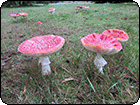 photo by splunge
photo by splunge
 photo by TheophileEscargot
photo by TheophileEscargot
 photo by Kronos_to_Earth
photo by Kronos_to_Earth
 photo by ethylene
photo by ethylene
Comment Feed:
♦ RSS
The myth of Halloween bogeymen and bogeywomen might never have been exposed had not a sociologist named Joel Best... established in a scholarly article in 1985 that there has not been a single death or serious injury. He uncovered a few incidents where children received minor cuts from sharp objects in their candy bags, but the vast majority of reports turned out to be old-fashioned hoaxes, sometimes enacted by young pranksters, other times by parents hoping to make money in lawsuits or insurance scams.
Ironically, in the only two known cases where children apparently did die from poisoned Halloween candy, the myth of the anonymous, sadistic stranger was used to cover up the real crime. In the first incident family members sprinkled heroin on a five-year-old’s Halloween candy in hopes of fooling the police about the cause of the child’s death. Actually, the boy had found and eaten heroin in his uncle’s home. In the second incident a boy died after eating cyanide-poisoned candy on Halloween, but police determined that his father had spiked the candy to collect insurance money. Bill Ellis, a professor of English at Penn State University, has commented that both of these incidents, reported in the press at first as stranger murders, "reinforced the moral of having parents examine treats-ironically, because in both cases family members were responsible for the children’s deaths!"
Yet if anonymous Halloween sadists were fictitious creatures, they were useful diversions from some truly frightening realities, such as the fact that far more children are seriously injured and killed by family members than by strangers. Halloween sadists also served in news stories as evidence that particular social trends were having ill effects on the populace. A psychiatrist quoted in the New York Times article held that Halloween sadism was a by-product of "the permissiveness in today’s society." The candy poisoner him- or herself was not directly to blame, the doctor suggested. The real villains were elsewhere. "The people who give harmful treats to children see criminals and students in campus riots getting away with things," the Times quoted him, "so they think they can get away with it, too."